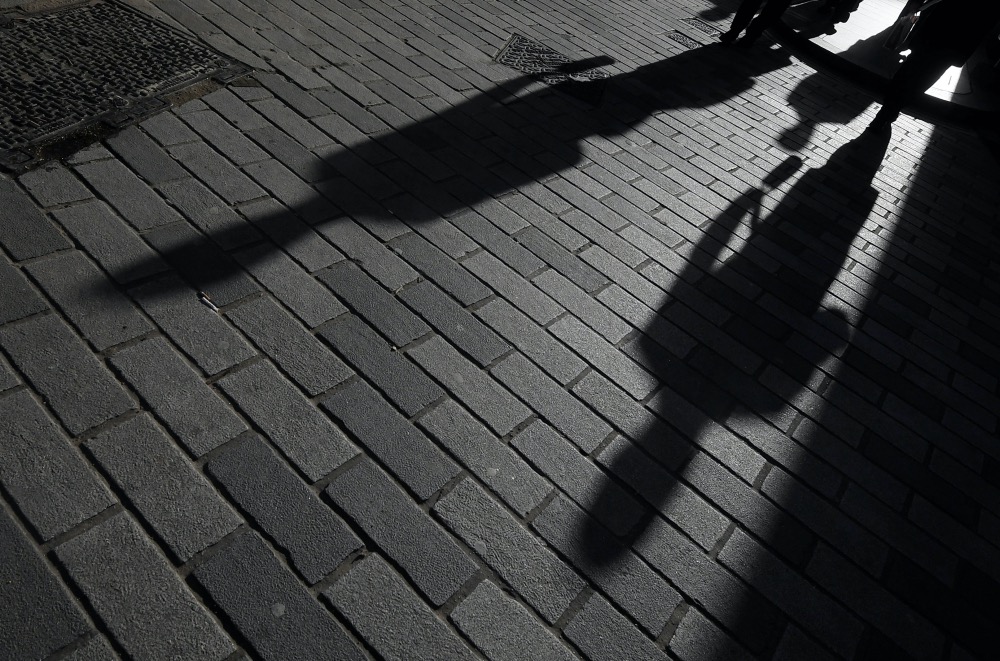Mexico City, Mexico
Thomson Reuters Foundation
Global protests about racism and police brutality should act as a wake-up call to the anti-human trafficking movement over the approach of law enforcement, treatment of Black victims and a lack of racial diversity, academics and activists said.
The legacy of ‘white slave traffic’ – a century-old Western narrative portraying white women as victims and foreign or Black men as criminals – affects anti-trafficking efforts in myriad ways today, particularly in criminal justice, researchers say.

The shadows of workers are seen in the City of London financial district, London, Britain, on 25th January, 2018. PICTURE: Reuters/Toby Melville/File photo
Many human trafficking policymakers and non-profits – whether in the United States, Britain or Thailand – focus on securing convictions, longer sentences, police training and victim cooperation as leading solutions to the complex problem.
Yet advocates fear this comes at the expense of addressing broader underlying causes such as poverty, immigration policies or domestic violence. It also means relying on criminal justice systems that are biased against Black people, academics said.
“The way that law enforcement is addressing [human trafficking] right now is a microcosm of everything that the Black Lives Matter movement is talking about,” said Vanessa Bouche, an Associate Professor at Texas Christian University.
Between 2005 and 2015, 57 per cent of defendants in US federal minor sex trafficking trials, a focus for prosecutors, were African-American, said Bouche, who built a case database. Yet only about 13 per cent of the US population is African-American.
On average, Black people convicted of sex trafficking minors are sentenced for 39 months longer than white people, she added.
And Black victims discovered by police on anti-trafficking raids are routinely treated with suspicion, said Bridgette Carr, director of the University of Michigan Law School’s Human Trafficking Clinic, which gives free legal support to victims.
Trafficking victims are often arrested for crimes they had been forced to commit – from prostitution to dealing drugs.
“We know that Black victims…are pushed more into being criminals and not being offered services,” Carr said, adding that the racialised idea of “perfect victims” who always cooperate with police was damaging to anti-trafficking efforts.
Debbie Ariyo, who runs the British charity Africans Unite Against Child Abuse, said Black trafficking victims were also often ignored or dismissed by authorities in Britain.
“Law enforcement agencies have failed to protect survivors due to a lack of knowledge and understanding of cultural practices that foster trafficking and exploitation,” she wrote in a recent opinion piece for the Thomson Reuters Foundation.
‘”White slavery”
English and American laws and global agreements from the early 1900s referred to ‘white slave traffic’, focusing on sex trafficking of white women mainly by immigrants or Black people.
In Latin America today, the issue is still described in some parts as ‘trata de blancas’ or ‘the trafficking of white women’.
“The racialised narratives have always been central to anti-trafficking narrative or storytelling,” said Brian Donovan, a cultural and historical sociologist at the University of Kansas.
Similar rhetoric is now used by some anti-trafficking groups to portray women in the sex trade as “innocents” in need of rescue, which obscures the complex reality of sex work, he said.
Yet this legacy or the impact of a criminal justice focus on Black people are rarely discussed in anti-trafficking circles – be it by the feminist left or the conservative Christian right – according to academics and activists working on the issue.
Part of the problem is that the non-profits involved in the movement are also too white, said Ariyo of AFRUCA in Britain.
“It’s not diverse in any way or form,” she said, adding that many groups working with victims from Nigeria and Albania, for example, had no knowledge or understanding of those countries.
In addition to becoming more diverse, organizations should consider allying with groups looking at broader structural problems related to trafficking from poverty to prison reform and immigration to domestic violence, several researchers said.
About 40.3 million people globally are estimated by the United Nations’ International Labour Organization to be enslaved today, more than at any point in history.
Yet some researchers are concerned by the widespread use of the term ‘modern slavery’ – which encompasses sex trafficking, forced labour and forced marriages – for its association and reliance on comparisons with the trans-Atlantic slave trade.
The term undermines the work needed to address the racism that originated in slavery, said Jennifer Suchland, an Associate Professor at Ohio State University and author on trafficking.
“Anti-trafficking organisations are not seeing the ways in which we are complicit in the continued erasure of the legacy of slavery on the present,” said Suchland.





